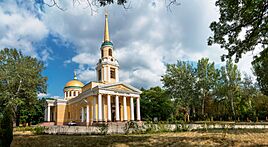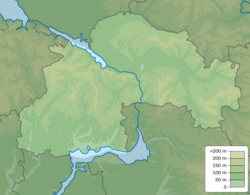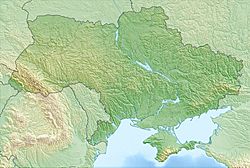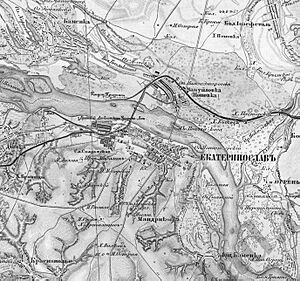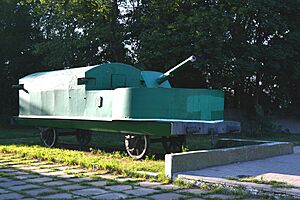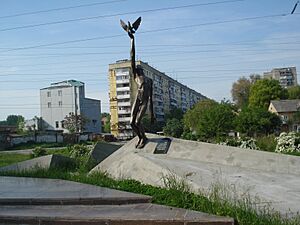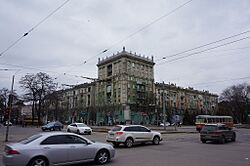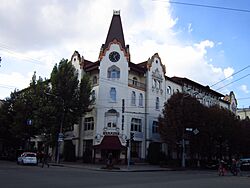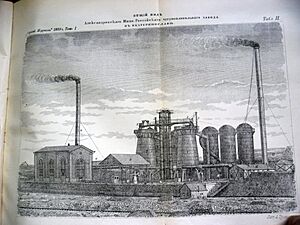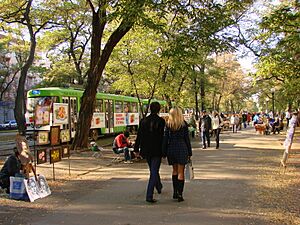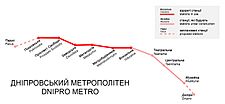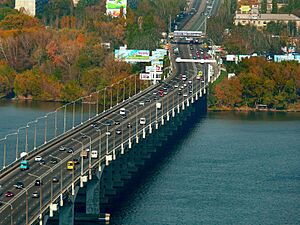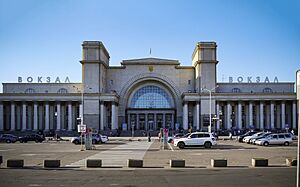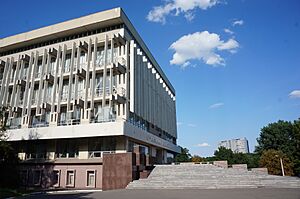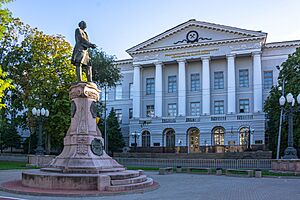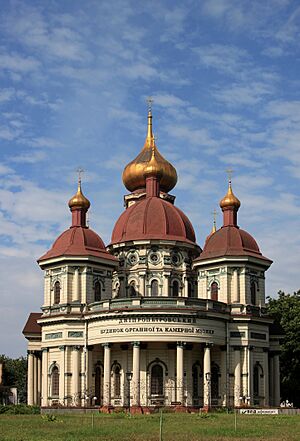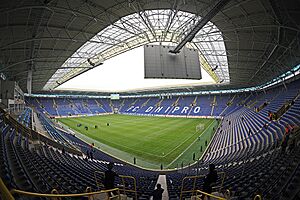Dnipro facts for kids
Quick facts for kids
Dnipro
Дніпро
|
|||||
|---|---|---|---|---|---|
|
City
|
|||||
| Ukrainian transcription(s) | |||||
| • Romanization | Dnipro | ||||
|
|||||
|
|||||
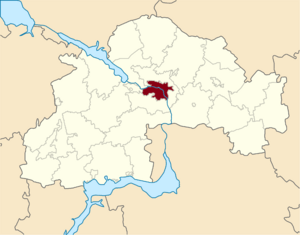
Dnipro's location within Dnipropetrovsk Oblast
|
|||||
| Country | |||||
| Oblast | Dnipropetrovsk Oblast | ||||
| Raion | Dnipro Raion | ||||
| Hromada | Dnipro urban hromada | ||||
| Founded | 1776 (249 years ago) (officially) | ||||
| City Status | 1778 | ||||
| Administrative HQ | Dnipro City Hall, 75 Akademik Yavornitskyi Prospekt |
||||
| Raions |
List of 8
Amur-Nyzhnodniprovskyi
Chechelivskyi Industrialnyi Novokodatskyi Samarskyi Shevchenkivskyi Sobornyi Tsentralnyi |
||||
| Government | |||||
| • Type | City council, regional | ||||
| Area | |||||
| • City | 409.718 km2 (158.193 sq mi) | ||||
| • Metro | 5,606 km2 (2,164 sq mi) | ||||
| Elevation | 155 m (509 ft) | ||||
| Population
(2022)
|
|||||
| • City | 968,502 | ||||
| • Rank | 4th in Ukraine | ||||
| • Density | 2,411/km2 (6,240/sq mi) | ||||
| • Metro | |||||
| Demonym(s) | Dniprianyn, Dniprianka, Dnipriany | ||||
| Time zone | UTC+2 (EET) | ||||
| • Summer (DST) | UTC+3 (EEST) | ||||
| Postal code |
49000—49489
|
||||
| Area code(s) | +380 56(2) | ||||
| Website | dniprorada.gov.ua | ||||
Dnipro is Ukraine's fourth-largest city, home to about one million people. It is located in eastern Ukraine, about 391 kilometers (243 miles) southeast of the capital city, Kyiv. The city sits on the Dnipro River, which is where its name comes from. Dnipro is also the main administrative center for the Dnipropetrovsk Oblast region.
Archaeological finds show that Cossack communities lived here as early as 1524. The city was officially founded in 1787 by Catherine the Great, the Russian Empress, and was first called Yekaterinoslav. In the late 1800s, the city grew quickly as a center for industry, attracting workers from many different backgrounds. They came to work with iron ore from Kryvbas and coal from Donbas.
In 1926, the city was renamed Dnipropetrovsk after a Communist Party leader. It became a major hub for heavy industry, including factories for rockets and space technology. Because of its importance, Dnipropetrovsk was a "closed city" during the Cold War, meaning foreigners couldn't visit.
After events in 2014, the city moved away from pro-Russian politics. In 2016, due to laws against communist symbols, the city's name was changed back to Dnipro.
Contents
Understanding the City's Name
Why the Name Dnipro?
The city's current name, Dnipro (Ukrainian: Дніпро), comes from the Dnipro River it sits on. This name was officially adopted in 2016.
Past Names of Dnipro
Over time, the city has had several different names:
- Novyi Kodak (1645–1784): This was the name of an early Cossack settlement.
- Yekaterinoslav (1784–1796 and 1802–1918): Meaning "glory of Catherine," this name honored Empress Catherine the Great.
- Novorossiysk (1796–1802): A brief name change during the reign of Tsar Paul I.
- Sicheslav (1918–1921): An unofficial name proposed during a period of Ukrainian independence.
- Dnipropetrovsk (1926–2016): Named after the Dnipro River and a Soviet leader, Grigory Petrovsky. During the Cold War, it was sometimes called the Rocket City because of its missile factories.
How the Name Changed
The original settlement was called Novyi Kodak. In 1784, Empress Catherine II ordered a new city, Yekaterinoslav, to be built near the Dnieper River.
In 1918, there was a suggestion to rename the city Sicheslav, but this never fully happened. In 1926, it was officially renamed Dnipropetrovsk to honor Grigory Petrovsky, a Soviet leader.
In 2015, Ukraine passed a law to remove communist names and symbols. To follow this law, the city council changed the meaning of "Petrovsk" to honor Saint Peter instead of Petrovsky. However, on May 19, 2016, the Ukrainian parliament voted to officially rename the city to Dnipro. This change removed the link to the Soviet leader.
The surrounding region is still called Dnipropetrovsk Oblast because changing its name would require a complex change to the Ukrainian Constitution.
Exploring Dnipro's History
Early Settlements and Cossack Times
People have lived in the area around Dnipro since the Paleolithic era (thousands of years ago). Traces of ancient tribes, like the Cimmerians and Scythians, have been found here. Later, the area was part of Kievan Rus' and then the Golden Horde after the Mongol invasion.
In the 15th century, the region became part of the Polish–Lithuanian Commonwealth. A trading settlement existed here from at least 1524. In 1635, the Polish-Lithuanian Commonwealth built the Kodak Fortress near the Dnieper Rapids. This fortress was important for the Cossacks, who often fought over it. A Cossack town called New Kodak grew around the fortress.
The Kodak Fortress was later destroyed. In 1784, Empress Catherine II ordered the founding of a new city, Yekaterinoslav, in this area. Today, the seal of the old Kodak Palanka (Cossack province) is part of Dnipro's official coat of arms and flag.
The Imperial City: Yekaterinoslav
Founding Catherine's City
The city of Yekaterinoslav was first mentioned in 1776. It was initially built in a swampy area, which was a bad choice. So, in 1784, Empress Catherine the Great ordered the city to be moved to the right bank of the Dnieper River, where modern Dnipro is located.
In 1787, the Empress herself laid the first stone for the Transfiguration Cathedral. The plan was to make Yekaterinoslav a grand imperial capital, like Moscow or Saint Petersburg, with a university and palaces. However, these big plans were never fully completed.
Growth as an Industrial Hub
In the late 1800s, Yekaterinoslav became a major industrial city. This growth was boosted by the discovery of iron ore nearby and the development of coal mines. In 1884, a railway bridge was built across the Dnieper River, connecting the iron ore mines with the coal fields. This led to more factories and new parts of the city growing.
By 1897, Yekaterinoslav was one of the first cities in the Russian Empire to have electric trams. The population grew very fast, more than tripling in twenty years. Many people from different backgrounds moved to the city for work.
Life in the Soviet Era
After the Russian Revolution in 1917, the city went through a period of great change and conflict. Various groups fought for control, including Ukrainian forces, White Army forces, and Bolsheviks. The city was damaged, and its population decreased.
In 1922, the region became part of the Ukrainian Soviet Socialist Republic, which was a part of the Soviet Union. In 1926, the city was renamed Dnipropetrovsk.
The city played a big role in Stalin's plans to industrialize the Soviet Union. By the 1930s, Dnipropetrovsk was a major center for metal production and became one of the most urbanized areas in Soviet Ukraine. It also grew as a cultural and educational center with many colleges and a university.
However, this period also brought hardship. The surrounding countryside suffered greatly from forced collectivization and famine, known as the Holodomor, in 1932–33. Many people died, and the city's population changed as survivors moved there for work.
World War II and the Closed City
Dnipropetrovsk was occupied by Nazi Germany from 1941 to 1943 during World War II. During this time, many of the city's Jewish residents were killed. The city's population dropped significantly during the occupation.
After the war, Dnipropetrovsk became a very important center for military machine-building, especially for missiles and rocket engines. The Yuzhmash factory became famous for producing rockets. Because of its strategic importance, Dnipropetrovsk was declared a "closed city" in 1959. This meant that foreign visitors were not allowed, and even its own citizens had limited freedom to travel. The city remained closed until 1987, during the period of perestroika (reforms) in the Soviet Union.
Independent Ukraine
In 1991, Ukraine declared its independence from the Soviet Union. Most voters in Dnipropetrovsk supported this. The years after independence brought economic challenges, and the city's population decreased.
Recent History: Euromaidan and Renaming
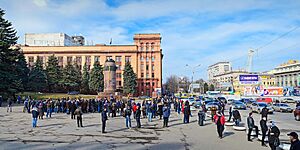
In 2014, during the Euromaidan protests against the Ukrainian President, Dnipropetrovsk saw some demonstrations. The city's leaders eventually supported keeping Ukraine united. After the president left Ukraine, monuments to Vladimir Lenin were removed from the city's squares.
To follow the 2015 laws against communist symbols, the city was renamed Dnipro in May 2016. Many streets and even some city districts also received new names. For example, Karl Marx Avenue, the main street, was renamed Akademik Yavornytskyi Prospekt, honoring a local historian.
More recently, in 2022 and 2023, Dnipro continued to remove monuments and rename streets that were linked to Russian culture or Soviet history. This included monuments to Russian figures and the renaming of avenues.
Geography of Dnipro
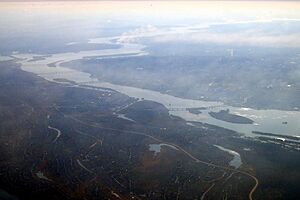
Dnipro is built on both sides of the Dnieper River, where it meets the Samara River. The Dnieper River changes its direction here, flowing south towards the Black Sea.
Both the north and south banks of the river are home to many factories and industrial businesses. The city's airport is located about 15 kilometers (9 miles) southeast of the city center.
The main part of the city is on the right bank of the Dnieper, which is higher ground. The left bank is flatter. The older part of the city is on a hill formed by the river's path.
Akademik Yavornitskyi Prospekt is a key street that connects important parts of the city center. It is a vital route for travel within and around Dnipro.
Climate in Dnipro
Dnipro has a climate with four clear seasons: a cold, snowy winter; a hot summer; and two wetter periods in spring and autumn.
- Summer (June-August) is very warm, with average daytime temperatures in July around 24 to 28 degrees Celsius (75-82°F). It can sometimes get as hot as 32 to 36 degrees Celsius (90-97°F).
- Winter (December-February) is cold, with average daytime temperatures in January around -4 to 0 degrees Celsius (25-32°F). Snow and rain often mix in December.
The best times to visit Dnipro are in late spring (late April and May) and early autumn (September and October), when the weather is pleasant and the trees change color.
While the city is beautiful, it faces challenges with air and water pollution from its many industries.
| Climate data for Dnipro (1991–2020, extremes 1948–present) | |||||||||||||
|---|---|---|---|---|---|---|---|---|---|---|---|---|---|
| Month | Jan | Feb | Mar | Apr | May | Jun | Jul | Aug | Sep | Oct | Nov | Dec | Year |
| Record high °C (°F) | 12.3 (54.1) |
17.5 (63.5) |
24.1 (75.4) |
31.8 (89.2) |
36.1 (97.0) |
37.8 (100.0) |
39.8 (103.6) |
40.9 (105.6) |
36.5 (97.7) |
32.6 (90.7) |
20.6 (69.1) |
13.7 (56.7) |
40.9 (105.6) |
| Mean daily maximum °C (°F) | −0.9 (30.4) |
0.6 (33.1) |
7.1 (44.8) |
16.0 (60.8) |
22.7 (72.9) |
26.6 (79.9) |
29.1 (84.4) |
28.7 (83.7) |
22.4 (72.3) |
14.4 (57.9) |
5.8 (42.4) |
0.6 (33.1) |
14.4 (57.9) |
| Daily mean °C (°F) | −3.6 (25.5) |
−2.8 (27.0) |
2.5 (36.5) |
10.3 (50.5) |
16.5 (61.7) |
20.5 (68.9) |
22.7 (72.9) |
22.1 (71.8) |
16.2 (61.2) |
9.2 (48.6) |
2.6 (36.7) |
−1.9 (28.6) |
9.5 (49.1) |
| Mean daily minimum °C (°F) | −6.1 (21.0) |
−5.8 (21.6) |
−1.2 (29.8) |
5.1 (41.2) |
10.9 (51.6) |
15.1 (59.2) |
17.1 (62.8) |
16.3 (61.3) |
11.0 (51.8) |
5.2 (41.4) |
−0.1 (31.8) |
−4.2 (24.4) |
5.3 (41.5) |
| Record low °C (°F) | −30.0 (−22.0) |
−27.8 (−18.0) |
−19.2 (−2.6) |
−8.2 (17.2) |
−2.4 (27.7) |
3.9 (39.0) |
5.9 (42.6) |
3.9 (39.0) |
−3.0 (26.6) |
−8.0 (17.6) |
−17.9 (−0.2) |
−27.8 (−18.0) |
−30.0 (−22.0) |
| Average precipitation mm (inches) | 50 (2.0) |
43 (1.7) |
51 (2.0) |
39 (1.5) |
51 (2.0) |
64 (2.5) |
55 (2.2) |
45 (1.8) |
42 (1.7) |
39 (1.5) |
44 (1.7) |
46 (1.8) |
569 (22.4) |
| Average extreme snow depth cm (inches) | 7 (2.8) |
10 (3.9) |
5 (2.0) |
0 (0) |
0 (0) |
0 (0) |
0 (0) |
0 (0) |
0 (0) |
0 (0) |
1 (0.4) |
4 (1.6) |
10 (3.9) |
| Average rainy days | 9 | 8 | 11 | 13 | 13 | 13 | 12 | 9 | 10 | 11 | 12 | 11 | 132 |
| Average snowy days | 16 | 15 | 9 | 1 | 0 | 0 | 0 | 0 | 0 | 1 | 7 | 15 | 64 |
| Average relative humidity (%) | 87.7 | 84.6 | 79.2 | 66.8 | 62.2 | 66.2 | 64.7 | 62.4 | 69.5 | 77.2 | 86.5 | 88.3 | 74.6 |
| Mean monthly sunshine hours | 50 | 74 | 132 | 196 | 266 | 281 | 310 | 285 | 211 | 142 | 62 | 37 | 2,046 |
| Source 1: Pogoda.ru.net | |||||||||||||
| Source 2: NOAA (humidity 1981–2010, sun 1991–2020) | |||||||||||||
City's Appearance and Architecture
Dnipro is a large industrial city. Its center features Stalinist architecture, which is a grand, monumental style from the Soviet era.
When Yekaterinoslav was first built, it grew outwards from the Transfiguration Cathedral. Many old buildings in the Sobornyi District still show the Neoclassical style of that time. Important buildings from before 1917 include the main building of the Dnipro Polytechnic and the Dnipropetrovsk National Historical Museum.
After the city became part of the Soviet Union and was renamed Dnipropetrovsk, many old monuments were removed. Buildings damaged in World War II were often torn down and replaced. Much of the city's main street, Akademik Yavornitskyi Prospekt, was rebuilt in the Stalinist style.
After 1953, industrial growth continued, and new factories were built. The city also expanded with new residential areas, especially on the left bank. Many apartment buildings from the Soviet era were built using prefabricated parts.
Since Ukraine became independent in 1991, new commercial and business centers have been built. Dnipro today has a mix of old and new architectural styles. You can see pre-revolutionary buildings, Stalinist designs, and modern structures. The city also has many private homes.
In 2014, a statue of Lenin was removed from Lenin Square, which was then renamed "Heroes of Independence Square." In 2015, over 350 streets and 5 of the 8 city districts were renamed to remove communist ties. More recently, monuments to figures of Russian history and culture have also been removed.
People of Dnipro
| Historical population | ||
|---|---|---|
| Year | Pop. | ±% |
| 1782 | 2,194 | — |
| 1800 | 6,389 | +191.2% |
| 1811 | 9,000 | +40.9% |
| 1825 | 8,412 | −6.5% |
| 1857 | 13,217 | +57.1% |
| 1862 | 19,515 | +47.7% |
| 1866 | 22,846 | +17.1% |
| 1885 | 46,876 | +105.2% |
| 1897 | 112,839 | +140.7% |
| 1926 | 187,570 | +66.2% |
| 1939 | 500,636 | +166.9% |
| 1943 | 280,000 | −44.1% |
| 1959 | 661,547 | +136.3% |
| 1970 | 862,100 | +30.3% |
| 1979 | 1,066,016 | +23.7% |
| 1989 | 1,177,897 | +10.5% |
| 2001 | 1,065,008 | −9.6% |
| 2011 | 1,004,853 | −5.6% |
| 2022 | 968,502 | −3.6% |
Dnipro has a population of about 1 million people. In 2011, the average age of residents was 40 years. The city's population growth is slightly higher than Ukraine's average.
Between 1923 and 1933, the percentage of Ukrainians in the city's population grew from 16% to 48%. This was part of a larger trend across Ukraine.
In a survey from 2017, 9% of residents said they spoke Ukrainian at home, 63% spoke Russian, and 25% spoke both equally. A 2023 survey showed 27% spoke Ukrainian at home and 66% spoke Russian.
Regarding religion in 2017:
- 49% belonged to the Ukrainian Orthodox Church of the Kyivan Patriarchate.
- 6% belonged to the Ukrainian Orthodox Church of the Moscow Patriarchate.
- 7% were atheists.
- 28% believed in God but did not belong to a specific religion.
Dnipro's Economy
Dnipro is a major industrial center in Ukraine. It has many large factories that produce a wide range of goods. These include cast-iron, rockets, metal products, pipes, and various types of machinery like tractors and trolleybuses.
The most famous and oldest factory is the Dniprovsky Metallurgical Plant, founded in the 19th century. Another important company is PA Pivdenmash, which makes heavy machinery and rockets.
Metal production is the city's main industry, making up over 47% of its industrial output. These companies contribute a lot to the city's budget and to Ukraine's foreign money reserves, as 80% of their products are exported. Dnipro is also a key place for importing foreign goods into the region.
The city's economy is largely driven by wholesale and retail trade. Many large businesses are based here. For example, Privat Group, a global business group, has its main office in Dnipro. It owns many companies in various industries. Privatbank, part of this group, is the largest commercial bank in Ukraine.
Another big company headquartered in Dnipro is ATB-Market, which owns the largest chain of retail stores in Ukraine. In 2018, a private American aerospace company, Firefly Aerospace, opened a research center in Dnipro to develop rockets for commercial space launches.
Getting Around Dnipro
Public Transport
In Dnipro, you can get around using trams, buses, and electric trolley buses. There are also many taxi services.
The city's roads can sometimes be in poor condition, but major roads and highways are better. Efforts have been made to improve public transport, with new trams bought from Germany and some roads being rebuilt.
Dnipro also has a metro system, which opened in 1995. It has one line with 6 stations. There are plans to expand the metro with three more stations, which would make the line longer. These new stations are expected to open in 2024 or later.
Travel Beyond the City
Several highways pass through Dnipro, connecting it to cities like Kyiv, Donetsk, and Kharkiv. A southern bypass road is being built to help traffic go around the city center, which will reduce pollution and improve transport.
Dnipro has the largest bus station in eastern Ukraine, with routes across the country and to other countries like Poland and Turkey. It is located near the central railway station.
In summer, you can sometimes travel by hydrofoil boats on the Dnieper River. Tourist ships also stop in Dnipro. The city's river port is near the central railway station.
Train Travel
Dnipro is a major railway hub. Many trains run daily to and from other parts of Ukraine and Eastern Europe. There are two main train stations: Dnipro Holovnyi (the main station) and Dnipro Lotsmanska (the south station).
Express trains connect Dnipro to Kyiv. There are also suburban trains to nearby towns. Most long-distance trains travel at night. You can take trains from Dnipro to cities like Lviv, Odesa, and Kharkiv in Ukraine. International train routes to countries like Belarus and Russia are no longer in service.
Air Travel
The city is served by Dnipro International Airport (DNK). It is about 15 kilometers (9 miles) southeast of the city center and has daily flights to European and Middle Eastern cities.
Education in Dnipro
Dnipro has 163 schools, including regular schools, gymnasiums, and boarding schools. There are also 174 institutions for preschool children and many after-school programs.
In a 2017 survey, most adults in Dnipro had completed vocational secondary education (46%) or university education (39%).
Dnipro is an important center for higher education. It is home to two of Ukraine's top universities: the Oles Honchar Dnipro National University and Dnipro Polytechnic National Technical University.
There are 38 higher education institutions in Dnipro. Annually, about 55,000 students study in Dnipro, including many from other countries.
Some of the key universities and academies in Dnipro include:
- Oles Honchar Dnipro National University: Founded over 90 years ago, it has 20 faculties and many specialties.
- Dnipro Polytechnic: A national technical university.
- Dnipro State Medical University: One of Ukraine's oldest medical schools.
- National Metallurgical Academy of Ukraine: Founded in 1899.
- Prydniprovska State Academy of Civil Engineering and Architecture: A member of the International Association of Universities.
- Dnipro National University of Railway Transport.
- Alfred Nobel University.
Culture and Attractions
Dnipro offers many cultural attractions. It has several theaters, including the Dnipro Academic Drama and Comedy Theatre and the Dnipro Opera and Ballet Theatre. There is also the Dnipro State Circus and various museums, such as the Dmytro Yavornytsky National Historical Museum and the Diorama "Battle of the Dnieper".
The city also has many restaurants, beaches, and parks like Taras Shevchenko Park and Sevastopol Park.
The central street is Akademik Yavornytskyi Prospekt, a wide boulevard that runs through the city center. It was established in the 18th century, and its buildings are a key part of the city's beauty. In the heart of the city is Soborna Square, home to the Transfiguration Cathedral, founded in 1787.
Near the Dnieper River is the large Taras Shevchenko Park and Monastyrskyi Island. In the 9th century, Byzantine monks had a monastery on this island.
The Governor's House, a 19th-century building, now houses the Museum of Dnipro City History. Some areas of the city, like parts of Central Avenue and sections near Globa and Shevchenko parks, have kept their historical look for over 150 years.
The Dnieper River helps keep the climate mild and offers beautiful views from many points in the city. From Dnipro's hills, you can see the river, islands, parks, and other parts of the city.
Religious Sites
- Holy Trinity Cathedral: An Eastern Orthodox cathedral from the 19th century.
- Dnipropetrovsk House Of Organ And Chamber Music: A performance hall that is also an Eastern Orthodox cathedral from the 20th century.
- Saint Nicholas Church: An Eastern Orthodox cathedral from the 19th century, it is the oldest church in Dnipro.
- Church of St. Catherine: A 19th-century Evangelical Lutheran church, it was the first church of its kind to open in Ukraine after independence.
Sports in Dnipro
FC Dnipro was the city's most successful football club. It was a runner-up in the Ukrainian Premier League and reached the final of the 2015 UEFA Europa League Final. The club is no longer active.
Other local football clubs include SC Dnipro-1, which plays in the Ukrainian Premier League and European competitions.
In 2008, the city built a new soccer stadium, the Dnipro-Arena, which can hold over 31,000 people. It hosted a 2010 FIFA World Cup qualification game between Ukraine and England.
Dnipro is also a center for bandy (a sport similar to ice hockey). The local bandy club, Dnipro, won the Ukrainian championship in 2014. The city is also home to BC Dnipro, a champion basketball team.
Famous People from Dnipro
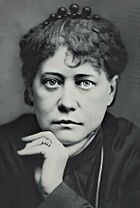
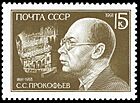
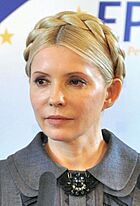
Many notable people were born or lived in Dnipro, including:
- Helena Blavatsky (1831–1891) – founder of the Theosophical Society.
- Oles Honchar (1918–1995) – a famous Ukrainian writer.
- Borys Filatov (born 1972) – the current mayor of Dnipro.
- Leonid Kuchma (born 1938) – served as President of Ukraine from 1994 to 2005.
- Viktor Pinchuk (born 1960) – a well-known businessman.
- Sergei Prokofiev (1891–1953) – a famous composer, pianist, and conductor.
- Yulia Tymoshenko (born 1960) – served as Prime Minister of Ukraine.
Sports Figures
- Oksana Baiul (born 1977) – a gold medalist in figure skating at the 1994 Winter Olympics.
- Artem Dolgopyat (born 1997) – an Israeli artistic gymnast and Olympic medalist.
- Yaroslava Mahuchikh (born 2001) – a high jumper.
- Igor Olshansky (born 1982) – a former NFL football player.
- Olesya Povh (born 1987) – an Olympic bronze medalist runner.
- Tatiana Volosozhar (born 1986) – a figure skating Olympic gold medalist in 2014.
Sister Cities
Dnipro has friendly relationships with several cities around the world:
 Dalian, China
Dalian, China Durham, Canada
Durham, Canada Herzliya, Israel
Herzliya, Israel Kutaisi, Georgia
Kutaisi, Georgia Szczecin, Poland
Szczecin, Poland Tashkent, Uzbekistan
Tashkent, Uzbekistan Vilnius, Lithuania
Vilnius, Lithuania Xi'an, China
Xi'an, China Žilina, Slovakia
Žilina, Slovakia
Friendship Cooperation Cities
Dnipro also cooperates with:
 Cologne, Germany
Cologne, Germany Osaka, Japan
Osaka, Japan- Grand Rapids, USA
Images for kids
-
A destroyed monument to Vladimir Lenin on Dnipro's Kalinin Avenue (now Prospekt Serhiy Nigoyan) in October 2014.
-
An aerial view of Dnipro. The Dnieper River, city's left and right banks, and a number of bridges can be seen.
-
Helena Blavatsky, 1877.
-
USSR stamp, centenary of Sergei Prokofiev, 1991.
-
Yulia Tymoshenko, 2011.
See also
 In Spanish: Dnipró para niños
In Spanish: Dnipró para niños



